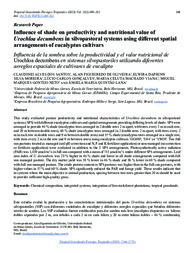Influence of shade on productivity and nutritional value of Urochloa decumbens in silvopastoral systems using different spatial arrangements of eucalyptus cultivars.
Influence of shade on productivity and nutritional value of Urochloa decumbens in silvopastoral systems using different spatial arrangements of eucalyptus cultivars.
Autoria: SANTOS, C. A. dos; OLIVEIRA, A. F. de; MOREIRA, E. D. S.; GONÇALVES, L. C.; VIANA, M. C. M.; GONTIJO NETO, M. M.; LANA, A. M. Q.
Resumo: This study evaluated pasture productivity and nutritional characteristics of Urochloa decumbens in silvopastoral systems (SPS) with different eucalyptus cultivars and spatial arrangements providing differing levels of shade. SPS were arranged to provide 46 % shade (eucalyptus trees arranged in 2 double rows 2 m apart, with trees every 3 m in each row, and 20 m between double rows), 60 % shade (eucalyptus trees arranged in 2 double rows 2 m apart, with trees every 2 m in each row in double rows and 9 m between double rows) and 57 % shade (eucalyptus trees arranged in a single row, with trees every 2 m in the row and 9 m between rows) using eucalyptus cultivars ?GG100?, ?I144? or ?VM58?. Two full sun pastures treated as managed (soil pH correction and N, P and K fertilizer application) or non-managed (no correction or fertilizer application) were evaluated in addition to the 3 SPS arrangements. Photosynthetically active radiation (PAR) was 1,439 ?mol/m2 /s in full sun compared with a mean of 715 ?mol/m2 /s under different SPS arrangements. Leaf area index of U. decumbens was 28 % higher in 46 % shade and lower in all shade arrangements compared with full sun managed pasture. The dry matter yield was 58 % lower in 46 % shade and 86 % lower in 60 % shade compared with full sun managed pasture. The crude protein content in SPS pastures was higher than in the full sun pastures, with higher values in 57 % and 60 % shade. SPS significantly reduced the PAR and forage yield. These results indicate that in systems where the main objective is animal production, spacing between tree rows greater than 20 m should be used to provide sufficient high-quality grass.
Ano de publicação: 2023
Tipo de publicação: Artigo de periódico
Unidade: Embrapa Milho e Sorgo
Observações
1 - Por padrão são exibidas publicações dos últimos 20 anos. Para encontrar publicações mais antigas, configure o filtro ano de publicação, colocando o ano a partir do qual você deseja encontrar publicações. O filtro está na coluna da esquerda na busca acima.
2 - Para ler algumas publicações da Embrapa (apenas as que estão em formato ePub), é necessário ter, no celular ou computador, um desses softwares gratuitos. Sistemas Android: Google Play Livros; IOS: iBooks; Windows e Linux: software Calibre.
Acesse outras publicações
Acesse a Base de Dados da Pesquisa Agropecuária (BDPA) para consultar o acervo completo das bibliotecas da Embrapa.

